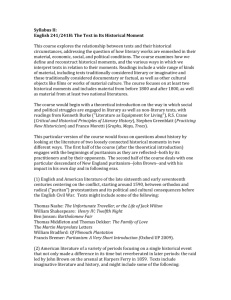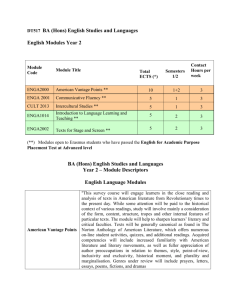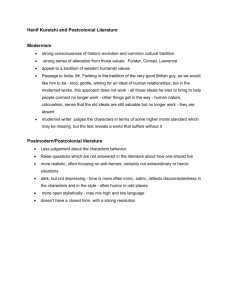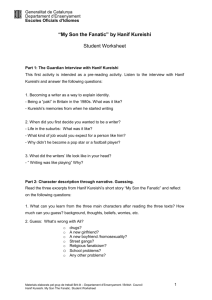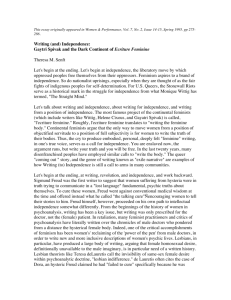Lecture Outlines: Unit 4
advertisement
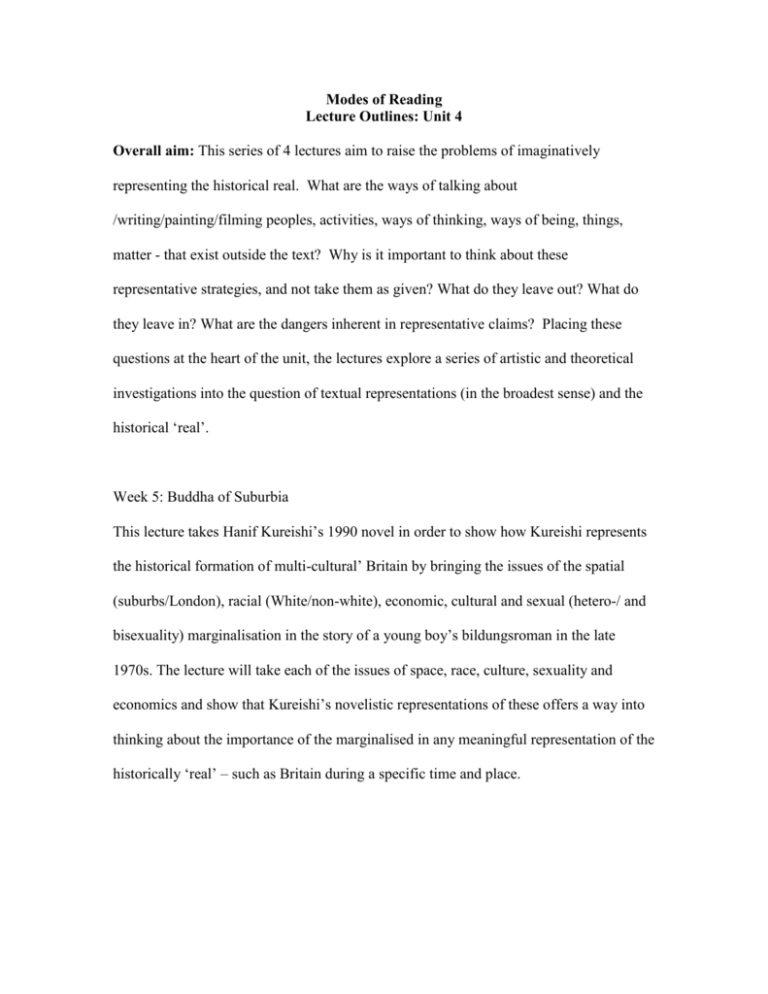
Modes of Reading Lecture Outlines: Unit 4 Overall aim: This series of 4 lectures aim to raise the problems of imaginatively representing the historical real. What are the ways of talking about /writing/painting/filming peoples, activities, ways of thinking, ways of being, things, matter - that exist outside the text? Why is it important to think about these representative strategies, and not take them as given? What do they leave out? What do they leave in? What are the dangers inherent in representative claims? Placing these questions at the heart of the unit, the lectures explore a series of artistic and theoretical investigations into the question of textual representations (in the broadest sense) and the historical ‘real’. Week 5: Buddha of Suburbia This lecture takes Hanif Kureishi’s 1990 novel in order to show how Kureishi represents the historical formation of multi-cultural’ Britain by bringing the issues of the spatial (suburbs/London), racial (White/non-white), economic, cultural and sexual (hetero-/ and bisexuality) marginalisation in the story of a young boy’s bildungsroman in the late 1970s. The lecture will take each of the issues of space, race, culture, sexuality and economics and show that Kureishi’s novelistic representations of these offers a way into thinking about the importance of the marginalised in any meaningful representation of the historically ‘real’ – such as Britain during a specific time and place. Week 7:Greenblatt If Kureishi raises the importance of the representative claims of the marginalised, Greenblatt’s essay asks us to think about what is it about texts that make us feel we are experiencing, or ‘touching’ the real. What is there in the way in which texts describe the historical, that makes us feel what we are reading about, or seeing, or listening to – is ‘real’? Greenblatt suggests it is a certain kind of description and ways of focalisation that achieves this reality effect – ‘thick’ description and foveation. This ‘ethnographic realism’ also has consequences for what we look at when we look for the ‘touch of the real’, since it involves reading literary and non-literary texts, canonical and non-canonical texts and complete and fragmentary texts, simultaneously and against each other. Thus, it is by bringing the marginal, the fragmentary, in relation to the central that we feel that imaginative texts succeed in touching the ‘real’. Week 8: McGann Continuing the points raised by Greenblatt, McGann urges us to think about the differences and therefore specific kinds of possible relationships between literary and non-literary, specifically historical texts and methods. It is all very well to say that we can touch the ‘real’ once we bring the literary and the historical into play with each other, but are these not fundamentally different kinds of things that yield to fundamentally different kinds of scholarship? McGann thinks that it is impossible to separate the literary from the socio-historical, but he suggests that we should clearly define exactly in what way they are related. This clear definition of the relationship between the literary and the socio-historical McGann outlines through a series of scholarly methods aimed at highlighting both their specificity and the interdependence. These methods excavate the social life of the author, the text and the audience (including the critics) in order to measure the ‘reality effect’ of a particular work of art. Week 9: Spivak and Guha Finally, we come to the disturbing question of the possible pitfalls of representing the historical real. All kinds of writers see giving voice and shape to the marginalised, including the fragmentary and thereby touching the historical ‘real’ as a politically progressive and aesthetically liberating thing to do. But what if, in the very moment of representation, the moment when we ‘touch the real’, we usurp and suppress exactly what is specifically historical about reality? Whereas Ranajit Guha reinforces the political and aesthetic necessity of scholars to include the marginal (subalterns) in their efforts to touch the ‘real’, Spivak raises the disquieting possibility that whenever we think we have succeeded in representing or reading the ‘real’ we are in fact suppressing or cancelling out aspects of that reality. By showing how the suicide of one Bengali woman was constantly misread by family members and scholars alike, Spivak shows some of the problems inherent in the celebratory accounts of representing the ‘real’.



